Comparative Study: Construction Materials and Building Services
VerifiedAdded on 2020/07/22
|29
|6148
|229
Report
AI Summary
This report provides a comprehensive analysis of common construction materials, including steel, copper, aluminum, timber, concrete, cement, and glass, detailing their properties and applications. It explores the performance of these materials in specific areas, such as concrete basements, steel structural frames, and aluminum facades. The report also delves into the loading of structural materials like reinforced concrete, structural steel, and timber, examining their general behavior, suitability, limitations, forms of loading, and inherent properties. Furthermore, it compares steel, reinforced concrete, and timber under various loads. Building services calculations, including thermal, artificial and natural lighting, and sound reverberation, are also presented. The integration of building services, such as internal and under-floor distribution, is discussed, along with heat loss and gain calculations, and a comparison of different concrete mixes based on slump and compressive strength tests, and tensile strength of steel reinforcing bars. The report concludes with a bibliography.
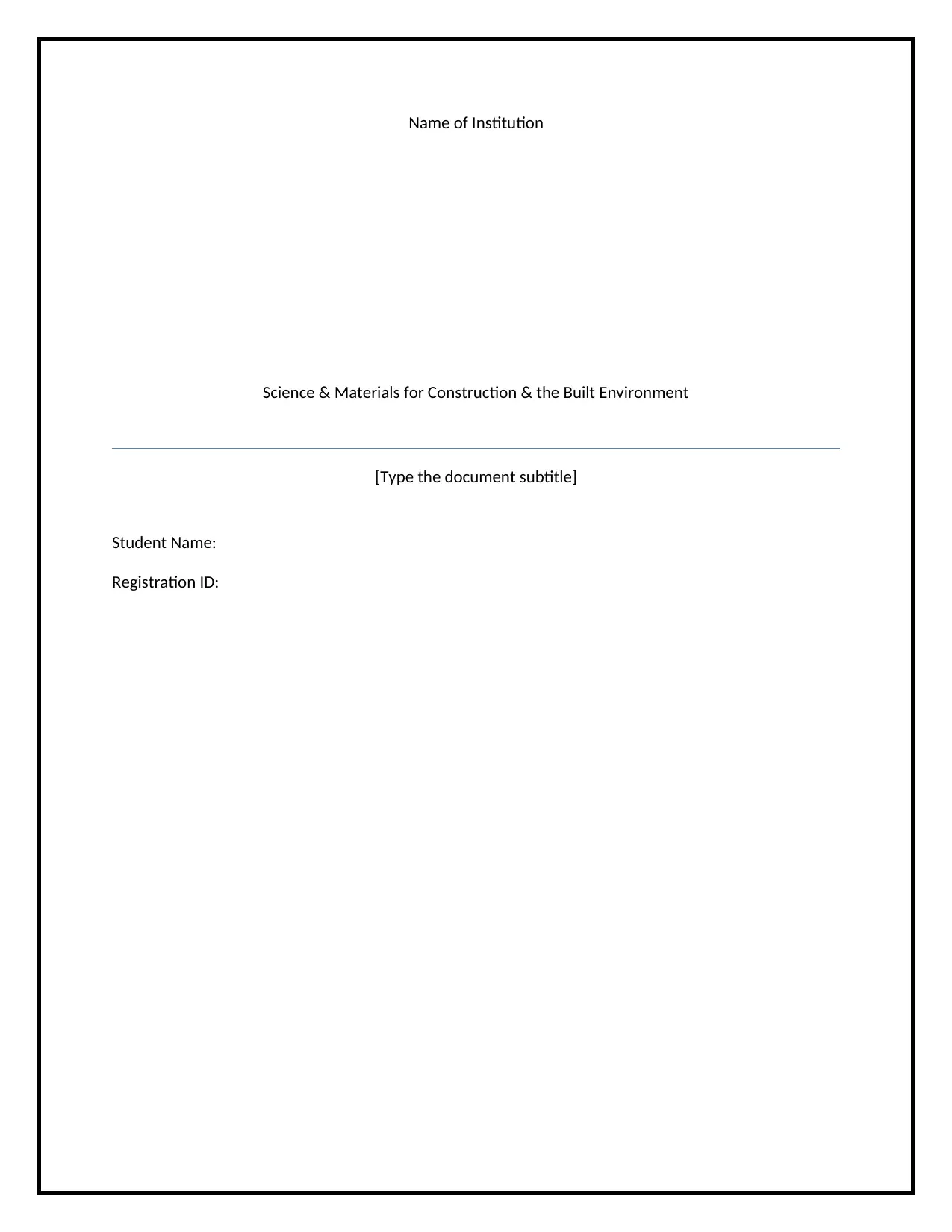
Name of Institution
Science & Materials for Construction & the Built Environment
[Type the document subtitle]
Student Name:
Registration ID:
Science & Materials for Construction & the Built Environment
[Type the document subtitle]
Student Name:
Registration ID:
Paraphrase This Document
Need a fresh take? Get an instant paraphrase of this document with our AI Paraphraser
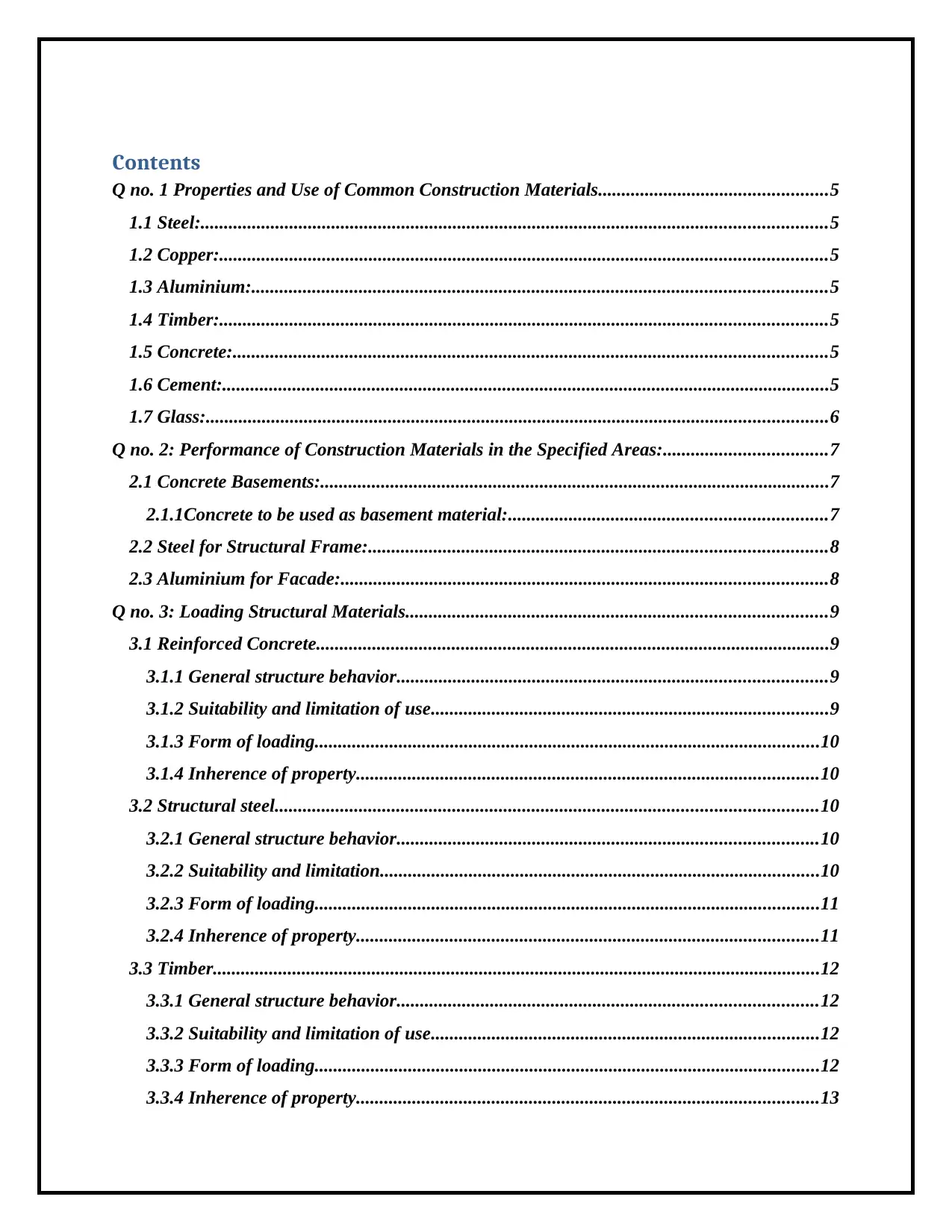
Contents
Q no. 1 Properties and Use of Common Construction Materials.................................................5
1.1 Steel:......................................................................................................................................5
1.2 Copper:..................................................................................................................................5
1.3 Aluminium:...........................................................................................................................5
1.4 Timber:..................................................................................................................................5
1.5 Concrete:...............................................................................................................................5
1.6 Cement:..................................................................................................................................5
1.7 Glass:.....................................................................................................................................6
Q no. 2: Performance of Construction Materials in the Specified Areas:...................................7
2.1 Concrete Basements:.............................................................................................................7
2.1.1Concrete to be used as basement material:....................................................................7
2.2 Steel for Structural Frame:..................................................................................................8
2.3 Aluminium for Facade:........................................................................................................8
Q no. 3: Loading Structural Materials..........................................................................................9
3.1 Reinforced Concrete..............................................................................................................9
3.1.1 General structure behavior............................................................................................9
3.1.2 Suitability and limitation of use.....................................................................................9
3.1.3 Form of loading............................................................................................................10
3.1.4 Inherence of property...................................................................................................10
3.2 Structural steel....................................................................................................................10
3.2.1 General structure behavior..........................................................................................10
3.2.2 Suitability and limitation..............................................................................................10
3.2.3 Form of loading............................................................................................................11
3.2.4 Inherence of property...................................................................................................11
3.3 Timber..................................................................................................................................12
3.3.1 General structure behavior..........................................................................................12
3.3.2 Suitability and limitation of use...................................................................................12
3.3.3 Form of loading............................................................................................................12
3.3.4 Inherence of property...................................................................................................13
Q no. 1 Properties and Use of Common Construction Materials.................................................5
1.1 Steel:......................................................................................................................................5
1.2 Copper:..................................................................................................................................5
1.3 Aluminium:...........................................................................................................................5
1.4 Timber:..................................................................................................................................5
1.5 Concrete:...............................................................................................................................5
1.6 Cement:..................................................................................................................................5
1.7 Glass:.....................................................................................................................................6
Q no. 2: Performance of Construction Materials in the Specified Areas:...................................7
2.1 Concrete Basements:.............................................................................................................7
2.1.1Concrete to be used as basement material:....................................................................7
2.2 Steel for Structural Frame:..................................................................................................8
2.3 Aluminium for Facade:........................................................................................................8
Q no. 3: Loading Structural Materials..........................................................................................9
3.1 Reinforced Concrete..............................................................................................................9
3.1.1 General structure behavior............................................................................................9
3.1.2 Suitability and limitation of use.....................................................................................9
3.1.3 Form of loading............................................................................................................10
3.1.4 Inherence of property...................................................................................................10
3.2 Structural steel....................................................................................................................10
3.2.1 General structure behavior..........................................................................................10
3.2.2 Suitability and limitation..............................................................................................10
3.2.3 Form of loading............................................................................................................11
3.2.4 Inherence of property...................................................................................................11
3.3 Timber..................................................................................................................................12
3.3.1 General structure behavior..........................................................................................12
3.3.2 Suitability and limitation of use...................................................................................12
3.3.3 Form of loading............................................................................................................12
3.3.4 Inherence of property...................................................................................................13
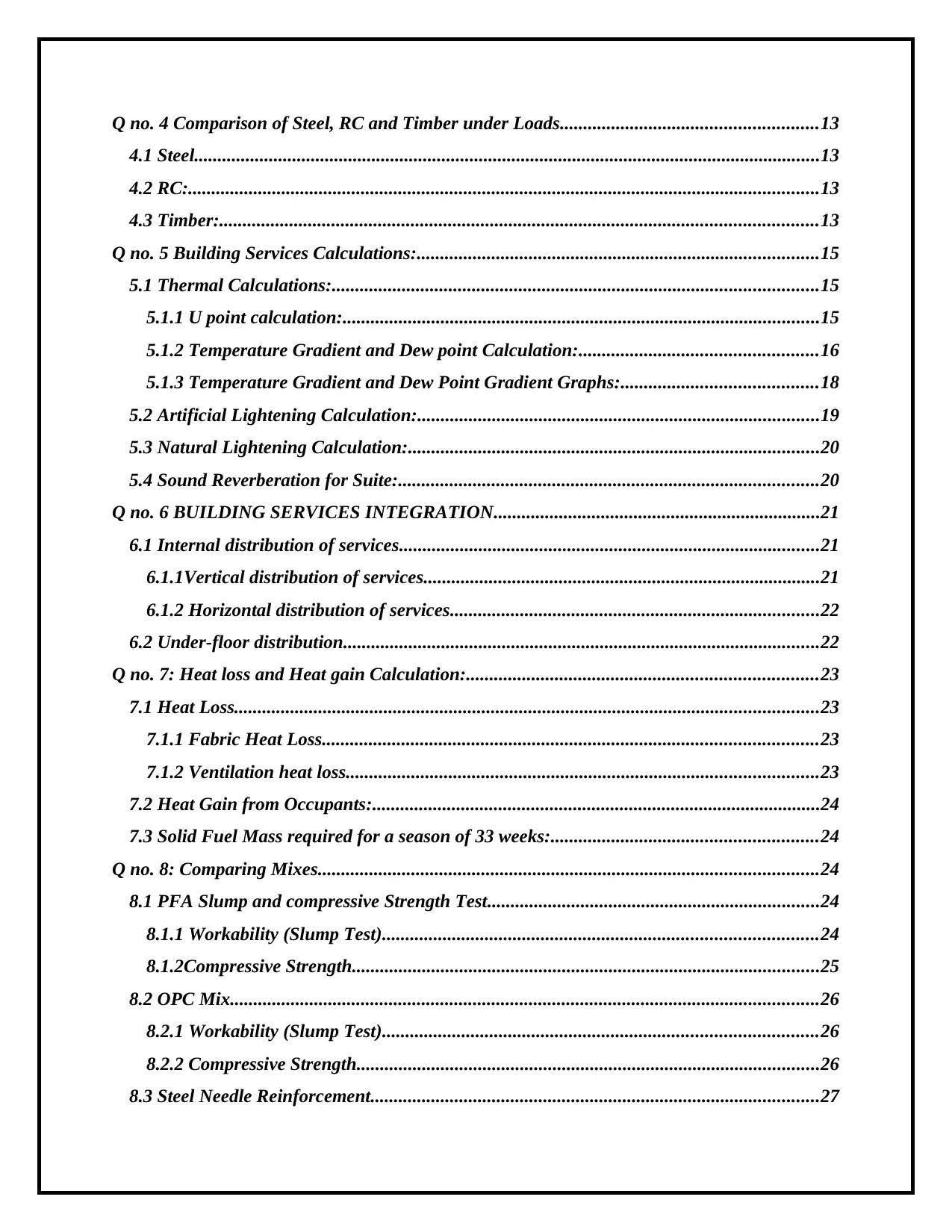
Q no. 4 Comparison of Steel, RC and Timber under Loads.......................................................13
4.1 Steel......................................................................................................................................13
4.2 RC:.......................................................................................................................................13
4.3 Timber:................................................................................................................................13
Q no. 5 Building Services Calculations:......................................................................................15
5.1 Thermal Calculations:........................................................................................................15
5.1.1 U point calculation:......................................................................................................15
5.1.2 Temperature Gradient and Dew point Calculation:...................................................16
5.1.3 Temperature Gradient and Dew Point Gradient Graphs:..........................................18
5.2 Artificial Lightening Calculation:......................................................................................19
5.3 Natural Lightening Calculation:........................................................................................20
5.4 Sound Reverberation for Suite:..........................................................................................20
Q no. 6 BUILDING SERVICES INTEGRATION......................................................................21
6.1 Internal distribution of services..........................................................................................21
6.1.1Vertical distribution of services.....................................................................................21
6.1.2 Horizontal distribution of services...............................................................................22
6.2 Under-floor distribution......................................................................................................22
Q no. 7: Heat loss and Heat gain Calculation:...........................................................................23
7.1 Heat Loss.............................................................................................................................23
7.1.1 Fabric Heat Loss..........................................................................................................23
7.1.2 Ventilation heat loss.....................................................................................................23
7.2 Heat Gain from Occupants:................................................................................................24
7.3 Solid Fuel Mass required for a season of 33 weeks:.........................................................24
Q no. 8: Comparing Mixes...........................................................................................................24
8.1 PFA Slump and compressive Strength Test.......................................................................24
8.1.1 Workability (Slump Test).............................................................................................24
8.1.2Compressive Strength....................................................................................................25
8.2 OPC Mix..............................................................................................................................26
8.2.1 Workability (Slump Test).............................................................................................26
8.2.2 Compressive Strength...................................................................................................26
8.3 Steel Needle Reinforcement................................................................................................27
4.1 Steel......................................................................................................................................13
4.2 RC:.......................................................................................................................................13
4.3 Timber:................................................................................................................................13
Q no. 5 Building Services Calculations:......................................................................................15
5.1 Thermal Calculations:........................................................................................................15
5.1.1 U point calculation:......................................................................................................15
5.1.2 Temperature Gradient and Dew point Calculation:...................................................16
5.1.3 Temperature Gradient and Dew Point Gradient Graphs:..........................................18
5.2 Artificial Lightening Calculation:......................................................................................19
5.3 Natural Lightening Calculation:........................................................................................20
5.4 Sound Reverberation for Suite:..........................................................................................20
Q no. 6 BUILDING SERVICES INTEGRATION......................................................................21
6.1 Internal distribution of services..........................................................................................21
6.1.1Vertical distribution of services.....................................................................................21
6.1.2 Horizontal distribution of services...............................................................................22
6.2 Under-floor distribution......................................................................................................22
Q no. 7: Heat loss and Heat gain Calculation:...........................................................................23
7.1 Heat Loss.............................................................................................................................23
7.1.1 Fabric Heat Loss..........................................................................................................23
7.1.2 Ventilation heat loss.....................................................................................................23
7.2 Heat Gain from Occupants:................................................................................................24
7.3 Solid Fuel Mass required for a season of 33 weeks:.........................................................24
Q no. 8: Comparing Mixes...........................................................................................................24
8.1 PFA Slump and compressive Strength Test.......................................................................24
8.1.1 Workability (Slump Test).............................................................................................24
8.1.2Compressive Strength....................................................................................................25
8.2 OPC Mix..............................................................................................................................26
8.2.1 Workability (Slump Test).............................................................................................26
8.2.2 Compressive Strength...................................................................................................26
8.3 Steel Needle Reinforcement................................................................................................27
⊘ This is a preview!⊘
Do you want full access?
Subscribe today to unlock all pages.

Trusted by 1+ million students worldwide
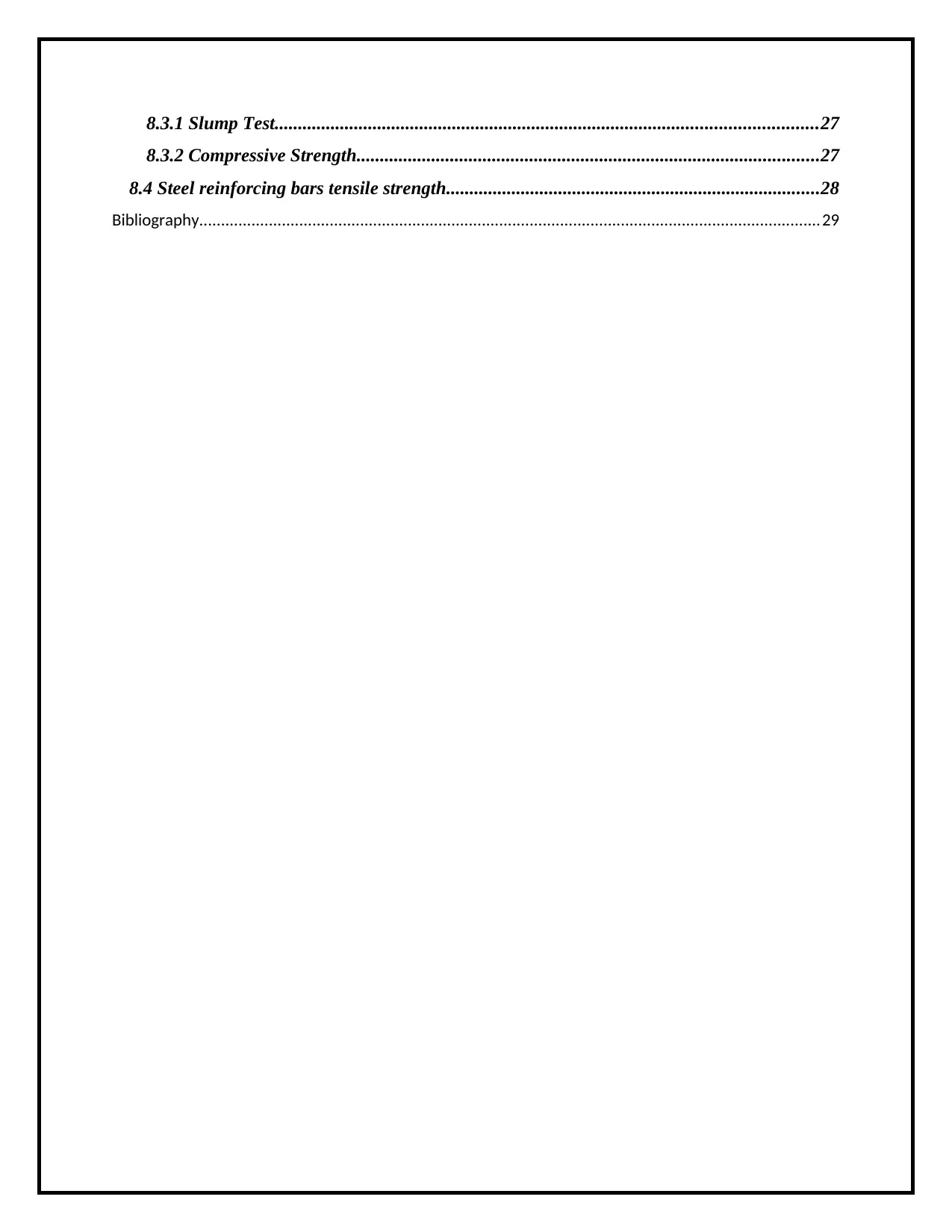
8.3.1 Slump Test....................................................................................................................27
8.3.2 Compressive Strength...................................................................................................27
8.4 Steel reinforcing bars tensile strength................................................................................28
Bibliography...............................................................................................................................................29
8.3.2 Compressive Strength...................................................................................................27
8.4 Steel reinforcing bars tensile strength................................................................................28
Bibliography...............................................................................................................................................29
Paraphrase This Document
Need a fresh take? Get an instant paraphrase of this document with our AI Paraphraser
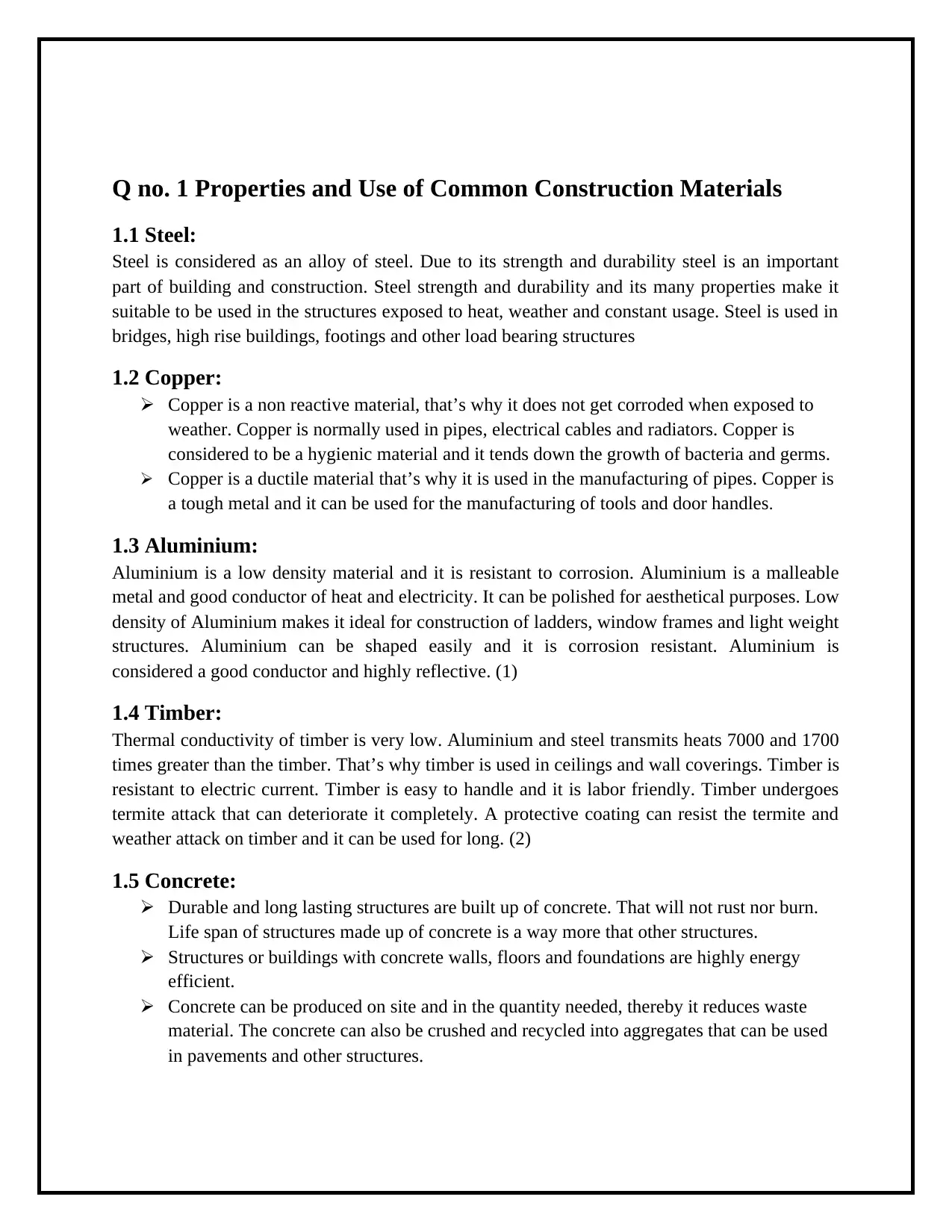
Q no. 1 Properties and Use of Common Construction Materials
1.1 Steel:
Steel is considered as an alloy of steel. Due to its strength and durability steel is an important
part of building and construction. Steel strength and durability and its many properties make it
suitable to be used in the structures exposed to heat, weather and constant usage. Steel is used in
bridges, high rise buildings, footings and other load bearing structures
1.2 Copper:
Copper is a non reactive material, that’s why it does not get corroded when exposed to
weather. Copper is normally used in pipes, electrical cables and radiators. Copper is
considered to be a hygienic material and it tends down the growth of bacteria and germs.
Copper is a ductile material that’s why it is used in the manufacturing of pipes. Copper is
a tough metal and it can be used for the manufacturing of tools and door handles.
1.3 Aluminium:
Aluminium is a low density material and it is resistant to corrosion. Aluminium is a malleable
metal and good conductor of heat and electricity. It can be polished for aesthetical purposes. Low
density of Aluminium makes it ideal for construction of ladders, window frames and light weight
structures. Aluminium can be shaped easily and it is corrosion resistant. Aluminium is
considered a good conductor and highly reflective. (1)
1.4 Timber:
Thermal conductivity of timber is very low. Aluminium and steel transmits heats 7000 and 1700
times greater than the timber. That’s why timber is used in ceilings and wall coverings. Timber is
resistant to electric current. Timber is easy to handle and it is labor friendly. Timber undergoes
termite attack that can deteriorate it completely. A protective coating can resist the termite and
weather attack on timber and it can be used for long. (2)
1.5 Concrete:
Durable and long lasting structures are built up of concrete. That will not rust nor burn.
Life span of structures made up of concrete is a way more that other structures.
Structures or buildings with concrete walls, floors and foundations are highly energy
efficient.
Concrete can be produced on site and in the quantity needed, thereby it reduces waste
material. The concrete can also be crushed and recycled into aggregates that can be used
in pavements and other structures.
1.1 Steel:
Steel is considered as an alloy of steel. Due to its strength and durability steel is an important
part of building and construction. Steel strength and durability and its many properties make it
suitable to be used in the structures exposed to heat, weather and constant usage. Steel is used in
bridges, high rise buildings, footings and other load bearing structures
1.2 Copper:
Copper is a non reactive material, that’s why it does not get corroded when exposed to
weather. Copper is normally used in pipes, electrical cables and radiators. Copper is
considered to be a hygienic material and it tends down the growth of bacteria and germs.
Copper is a ductile material that’s why it is used in the manufacturing of pipes. Copper is
a tough metal and it can be used for the manufacturing of tools and door handles.
1.3 Aluminium:
Aluminium is a low density material and it is resistant to corrosion. Aluminium is a malleable
metal and good conductor of heat and electricity. It can be polished for aesthetical purposes. Low
density of Aluminium makes it ideal for construction of ladders, window frames and light weight
structures. Aluminium can be shaped easily and it is corrosion resistant. Aluminium is
considered a good conductor and highly reflective. (1)
1.4 Timber:
Thermal conductivity of timber is very low. Aluminium and steel transmits heats 7000 and 1700
times greater than the timber. That’s why timber is used in ceilings and wall coverings. Timber is
resistant to electric current. Timber is easy to handle and it is labor friendly. Timber undergoes
termite attack that can deteriorate it completely. A protective coating can resist the termite and
weather attack on timber and it can be used for long. (2)
1.5 Concrete:
Durable and long lasting structures are built up of concrete. That will not rust nor burn.
Life span of structures made up of concrete is a way more that other structures.
Structures or buildings with concrete walls, floors and foundations are highly energy
efficient.
Concrete can be produced on site and in the quantity needed, thereby it reduces waste
material. The concrete can also be crushed and recycled into aggregates that can be used
in pavements and other structures.
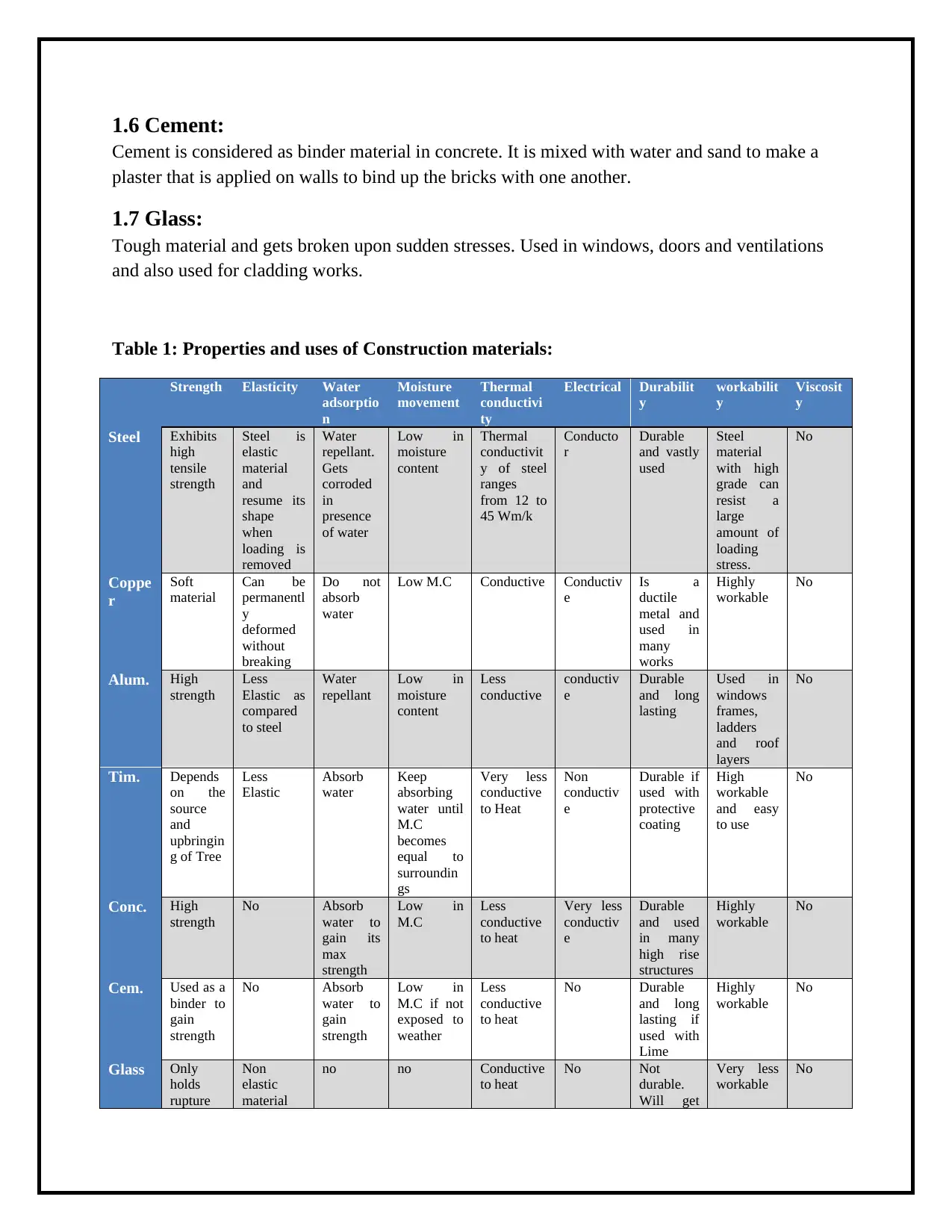
1.6 Cement:
Cement is considered as binder material in concrete. It is mixed with water and sand to make a
plaster that is applied on walls to bind up the bricks with one another.
1.7 Glass:
Tough material and gets broken upon sudden stresses. Used in windows, doors and ventilations
and also used for cladding works.
Table 1: Properties and uses of Construction materials:
Strength Elasticity Water
adsorptio
n
Moisture
movement
Thermal
conductivi
ty
Electrical Durabilit
y
workabilit
y
Viscosit
y
Steel Exhibits
high
tensile
strength
Steel is
elastic
material
and
resume its
shape
when
loading is
removed
Water
repellant.
Gets
corroded
in
presence
of water
Low in
moisture
content
Thermal
conductivit
y of steel
ranges
from 12 to
45 Wm/k
Conducto
r
Durable
and vastly
used
Steel
material
with high
grade can
resist a
large
amount of
loading
stress.
No
Coppe
r
Soft
material
Can be
permanentl
y
deformed
without
breaking
Do not
absorb
water
Low M.C Conductive Conductiv
e
Is a
ductile
metal and
used in
many
works
Highly
workable
No
Alum. High
strength
Less
Elastic as
compared
to steel
Water
repellant
Low in
moisture
content
Less
conductive
conductiv
e
Durable
and long
lasting
Used in
windows
frames,
ladders
and roof
layers
No
Tim. Depends
on the
source
and
upbringin
g of Tree
Less
Elastic
Absorb
water
Keep
absorbing
water until
M.C
becomes
equal to
surroundin
gs
Very less
conductive
to Heat
Non
conductiv
e
Durable if
used with
protective
coating
High
workable
and easy
to use
No
Conc. High
strength
No Absorb
water to
gain its
max
strength
Low in
M.C
Less
conductive
to heat
Very less
conductiv
e
Durable
and used
in many
high rise
structures
Highly
workable
No
Cem. Used as a
binder to
gain
strength
No Absorb
water to
gain
strength
Low in
M.C if not
exposed to
weather
Less
conductive
to heat
No Durable
and long
lasting if
used with
Lime
Highly
workable
No
Glass Only
holds
rupture
Non
elastic
material
no no Conductive
to heat
No Not
durable.
Will get
Very less
workable
No
Cement is considered as binder material in concrete. It is mixed with water and sand to make a
plaster that is applied on walls to bind up the bricks with one another.
1.7 Glass:
Tough material and gets broken upon sudden stresses. Used in windows, doors and ventilations
and also used for cladding works.
Table 1: Properties and uses of Construction materials:
Strength Elasticity Water
adsorptio
n
Moisture
movement
Thermal
conductivi
ty
Electrical Durabilit
y
workabilit
y
Viscosit
y
Steel Exhibits
high
tensile
strength
Steel is
elastic
material
and
resume its
shape
when
loading is
removed
Water
repellant.
Gets
corroded
in
presence
of water
Low in
moisture
content
Thermal
conductivit
y of steel
ranges
from 12 to
45 Wm/k
Conducto
r
Durable
and vastly
used
Steel
material
with high
grade can
resist a
large
amount of
loading
stress.
No
Coppe
r
Soft
material
Can be
permanentl
y
deformed
without
breaking
Do not
absorb
water
Low M.C Conductive Conductiv
e
Is a
ductile
metal and
used in
many
works
Highly
workable
No
Alum. High
strength
Less
Elastic as
compared
to steel
Water
repellant
Low in
moisture
content
Less
conductive
conductiv
e
Durable
and long
lasting
Used in
windows
frames,
ladders
and roof
layers
No
Tim. Depends
on the
source
and
upbringin
g of Tree
Less
Elastic
Absorb
water
Keep
absorbing
water until
M.C
becomes
equal to
surroundin
gs
Very less
conductive
to Heat
Non
conductiv
e
Durable if
used with
protective
coating
High
workable
and easy
to use
No
Conc. High
strength
No Absorb
water to
gain its
max
strength
Low in
M.C
Less
conductive
to heat
Very less
conductiv
e
Durable
and used
in many
high rise
structures
Highly
workable
No
Cem. Used as a
binder to
gain
strength
No Absorb
water to
gain
strength
Low in
M.C if not
exposed to
weather
Less
conductive
to heat
No Durable
and long
lasting if
used with
Lime
Highly
workable
No
Glass Only
holds
rupture
Non
elastic
material
no no Conductive
to heat
No Not
durable.
Will get
Very less
workable
No
⊘ This is a preview!⊘
Do you want full access?
Subscribe today to unlock all pages.

Trusted by 1+ million students worldwide
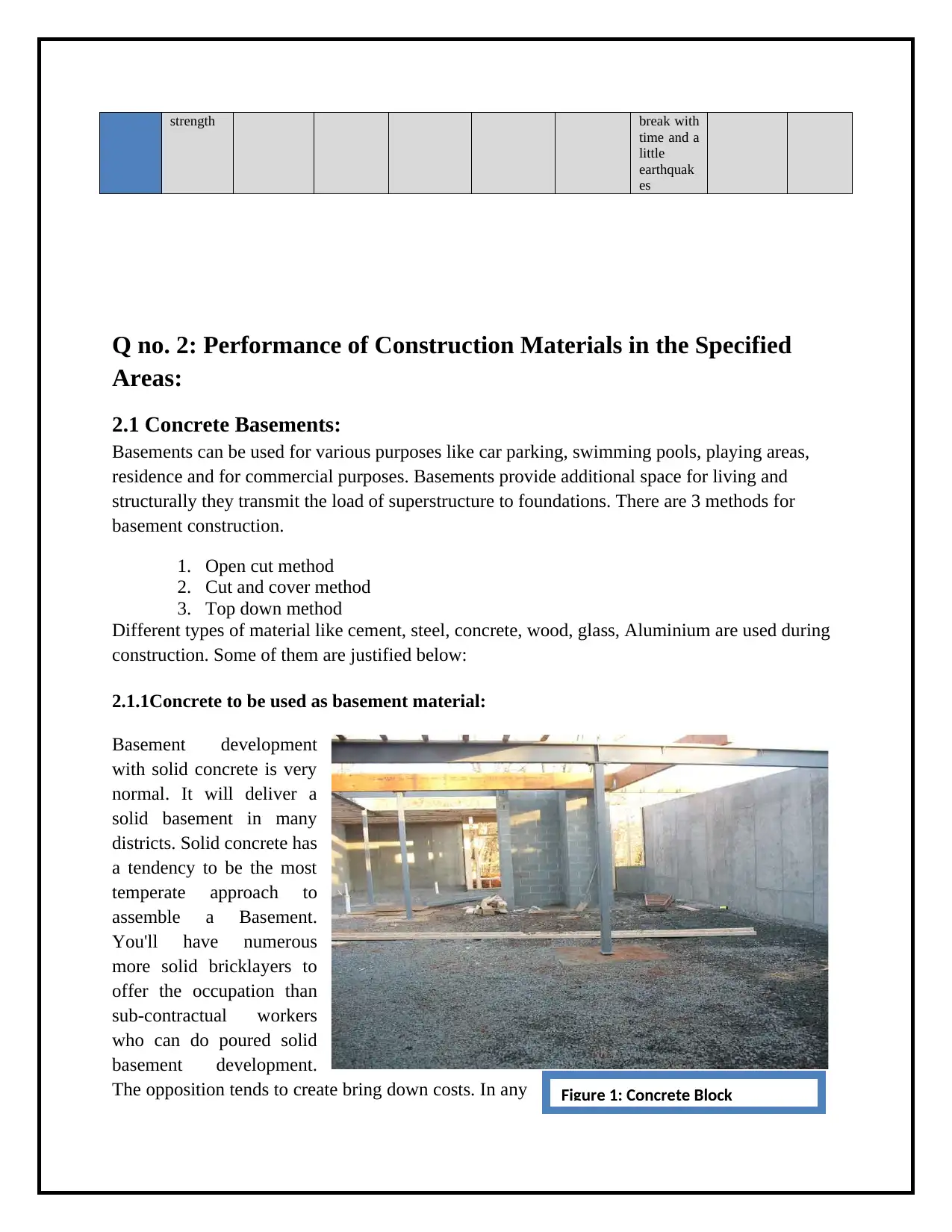
Figure 1: Concrete Block
strength break with
time and a
little
earthquak
es
Q no. 2: Performance of Construction Materials in the Specified
Areas:
2.1 Concrete Basements:
Basements can be used for various purposes like car parking, swimming pools, playing areas,
residence and for commercial purposes. Basements provide additional space for living and
structurally they transmit the load of superstructure to foundations. There are 3 methods for
basement construction.
1. Open cut method
2. Cut and cover method
3. Top down method
Different types of material like cement, steel, concrete, wood, glass, Aluminium are used during
construction. Some of them are justified below:
2.1.1Concrete to be used as basement material:
Basement development
with solid concrete is very
normal. It will deliver a
solid basement in many
districts. Solid concrete has
a tendency to be the most
temperate approach to
assemble a Basement.
You'll have numerous
more solid bricklayers to
offer the occupation than
sub-contractual workers
who can do poured solid
basement development.
The opposition tends to create bring down costs. In any
strength break with
time and a
little
earthquak
es
Q no. 2: Performance of Construction Materials in the Specified
Areas:
2.1 Concrete Basements:
Basements can be used for various purposes like car parking, swimming pools, playing areas,
residence and for commercial purposes. Basements provide additional space for living and
structurally they transmit the load of superstructure to foundations. There are 3 methods for
basement construction.
1. Open cut method
2. Cut and cover method
3. Top down method
Different types of material like cement, steel, concrete, wood, glass, Aluminium are used during
construction. Some of them are justified below:
2.1.1Concrete to be used as basement material:
Basement development
with solid concrete is very
normal. It will deliver a
solid basement in many
districts. Solid concrete has
a tendency to be the most
temperate approach to
assemble a Basement.
You'll have numerous
more solid bricklayers to
offer the occupation than
sub-contractual workers
who can do poured solid
basement development.
The opposition tends to create bring down costs. In any
Paraphrase This Document
Need a fresh take? Get an instant paraphrase of this document with our AI Paraphraser
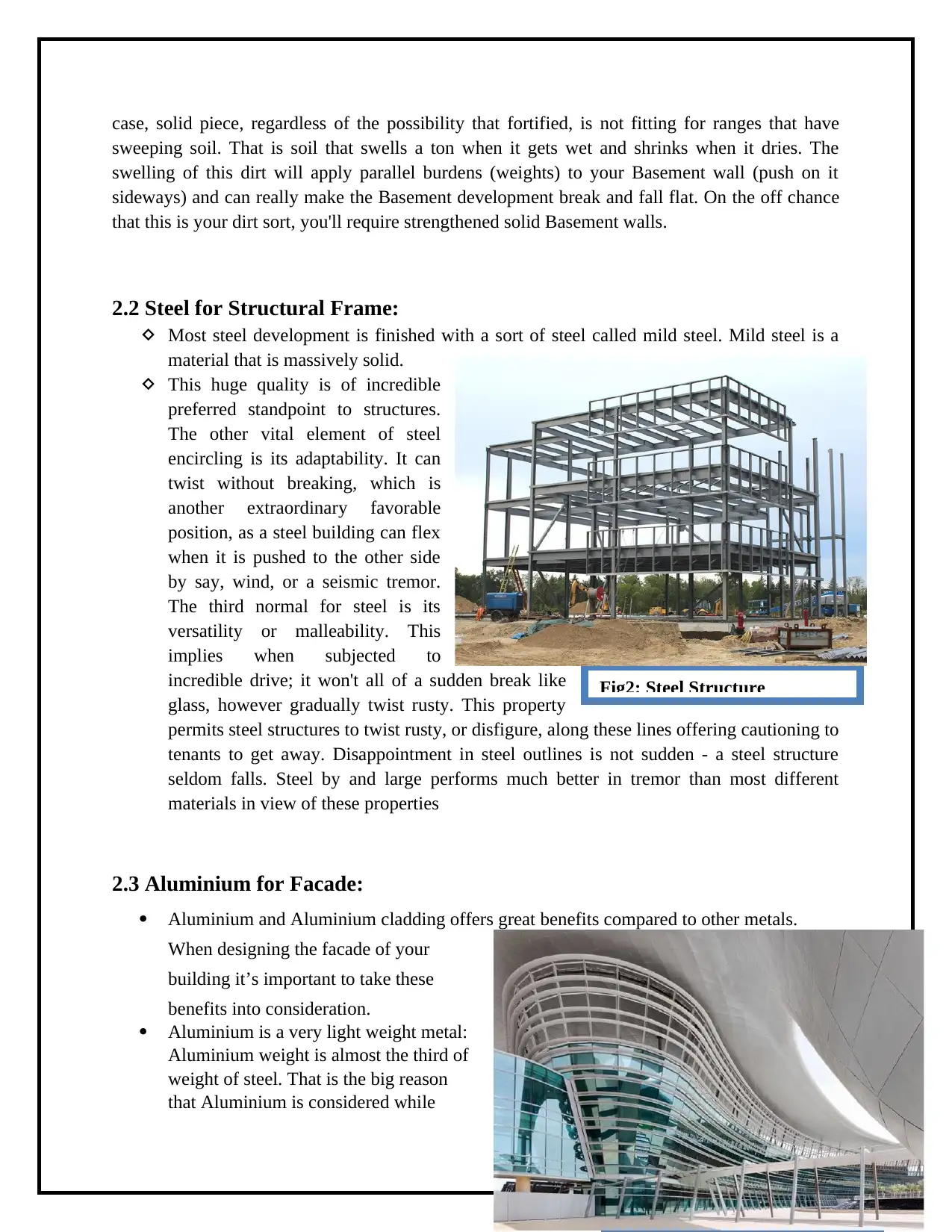
Fig2: Steel Structure
Fig3: Aluminium Façade
case, solid piece, regardless of the possibility that fortified, is not fitting for ranges that have
sweeping soil. That is soil that swells a ton when it gets wet and shrinks when it dries. The
swelling of this dirt will apply parallel burdens (weights) to your Basement wall (push on it
sideways) and can really make the Basement development break and fall flat. On the off chance
that this is your dirt sort, you'll require strengthened solid Basement walls.
2.2 Steel for Structural Frame:
Most steel development is finished with a sort of steel called mild steel. Mild steel is a
material that is massively solid.
This huge quality is of incredible
preferred standpoint to structures.
The other vital element of steel
encircling is its adaptability. It can
twist without breaking, which is
another extraordinary favorable
position, as a steel building can flex
when it is pushed to the other side
by say, wind, or a seismic tremor.
The third normal for steel is its
versatility or malleability. This
implies when subjected to
incredible drive; it won't all of a sudden break like
glass, however gradually twist rusty. This property
permits steel structures to twist rusty, or disfigure, along these lines offering cautioning to
tenants to get away. Disappointment in steel outlines is not sudden - a steel structure
seldom falls. Steel by and large performs much better in tremor than most different
materials in view of these properties
2.3 Aluminium for Facade:
Aluminium and Aluminium cladding offers great benefits compared to other metals.
When designing the facade of your
building it’s important to take these
benefits into consideration.
Aluminium is a very light weight metal:
Aluminium weight is almost the third of
weight of steel. That is the big reason
that Aluminium is considered while
Fig3: Aluminium Façade
case, solid piece, regardless of the possibility that fortified, is not fitting for ranges that have
sweeping soil. That is soil that swells a ton when it gets wet and shrinks when it dries. The
swelling of this dirt will apply parallel burdens (weights) to your Basement wall (push on it
sideways) and can really make the Basement development break and fall flat. On the off chance
that this is your dirt sort, you'll require strengthened solid Basement walls.
2.2 Steel for Structural Frame:
Most steel development is finished with a sort of steel called mild steel. Mild steel is a
material that is massively solid.
This huge quality is of incredible
preferred standpoint to structures.
The other vital element of steel
encircling is its adaptability. It can
twist without breaking, which is
another extraordinary favorable
position, as a steel building can flex
when it is pushed to the other side
by say, wind, or a seismic tremor.
The third normal for steel is its
versatility or malleability. This
implies when subjected to
incredible drive; it won't all of a sudden break like
glass, however gradually twist rusty. This property
permits steel structures to twist rusty, or disfigure, along these lines offering cautioning to
tenants to get away. Disappointment in steel outlines is not sudden - a steel structure
seldom falls. Steel by and large performs much better in tremor than most different
materials in view of these properties
2.3 Aluminium for Facade:
Aluminium and Aluminium cladding offers great benefits compared to other metals.
When designing the facade of your
building it’s important to take these
benefits into consideration.
Aluminium is a very light weight metal:
Aluminium weight is almost the third of
weight of steel. That is the big reason
that Aluminium is considered while
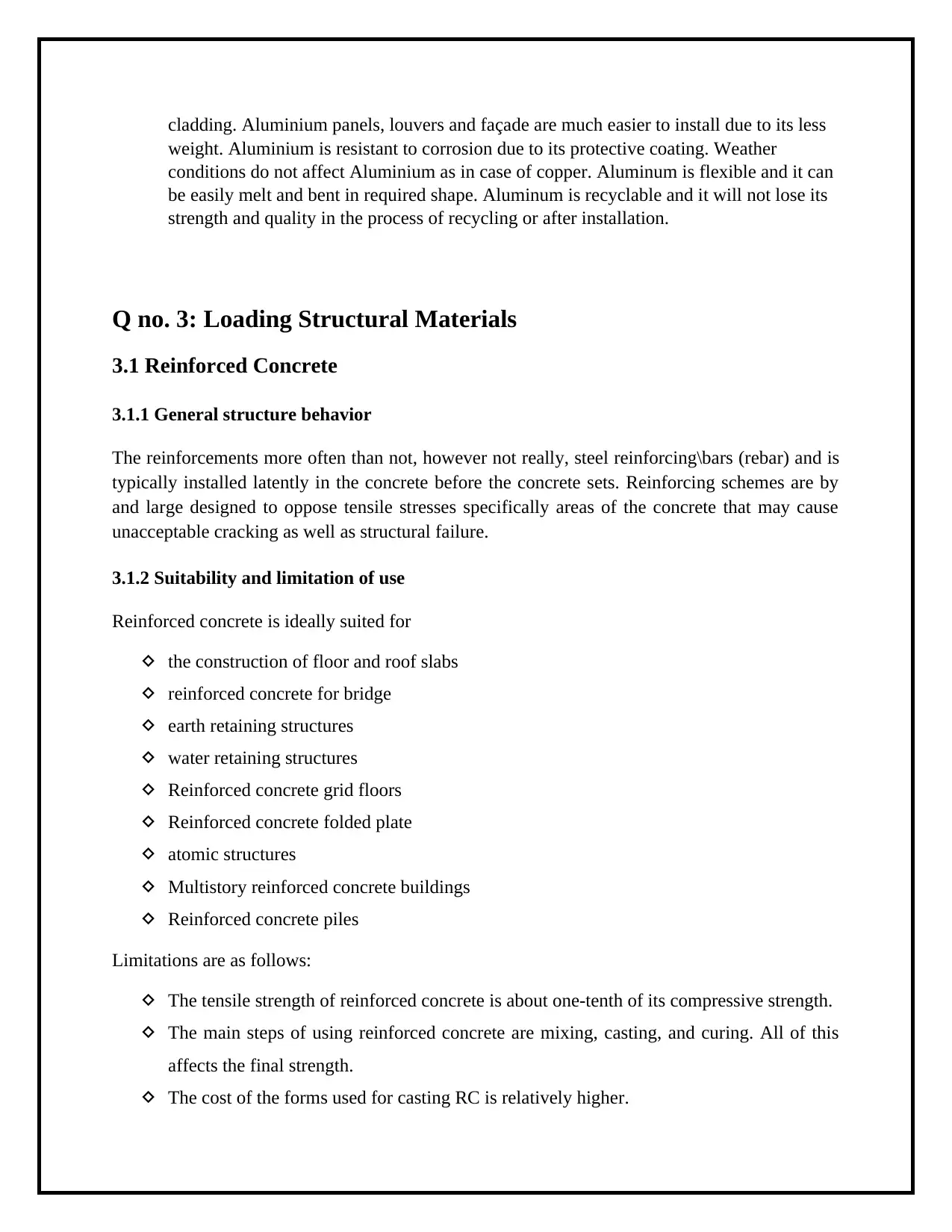
cladding. Aluminium panels, louvers and façade are much easier to install due to its less
weight. Aluminium is resistant to corrosion due to its protective coating. Weather
conditions do not affect Aluminium as in case of copper. Aluminum is flexible and it can
be easily melt and bent in required shape. Aluminum is recyclable and it will not lose its
strength and quality in the process of recycling or after installation.
Q no. 3: Loading Structural Materials
3.1 Reinforced Concrete
3.1.1 General structure behavior
The reinforcements more often than not, however not really, steel reinforcing\bars (rebar) and is
typically installed latently in the concrete before the concrete sets. Reinforcing schemes are by
and large designed to oppose tensile stresses specifically areas of the concrete that may cause
unacceptable cracking as well as structural failure.
3.1.2 Suitability and limitation of use
Reinforced concrete is ideally suited for
the construction of floor and roof slabs
reinforced concrete for bridge
earth retaining structures
water retaining structures
Reinforced concrete grid floors
Reinforced concrete folded plate
atomic structures
Multistory reinforced concrete buildings
Reinforced concrete piles
Limitations are as follows:
The tensile strength of reinforced concrete is about one-tenth of its compressive strength.
The main steps of using reinforced concrete are mixing, casting, and curing. All of this
affects the final strength.
The cost of the forms used for casting RC is relatively higher.
weight. Aluminium is resistant to corrosion due to its protective coating. Weather
conditions do not affect Aluminium as in case of copper. Aluminum is flexible and it can
be easily melt and bent in required shape. Aluminum is recyclable and it will not lose its
strength and quality in the process of recycling or after installation.
Q no. 3: Loading Structural Materials
3.1 Reinforced Concrete
3.1.1 General structure behavior
The reinforcements more often than not, however not really, steel reinforcing\bars (rebar) and is
typically installed latently in the concrete before the concrete sets. Reinforcing schemes are by
and large designed to oppose tensile stresses specifically areas of the concrete that may cause
unacceptable cracking as well as structural failure.
3.1.2 Suitability and limitation of use
Reinforced concrete is ideally suited for
the construction of floor and roof slabs
reinforced concrete for bridge
earth retaining structures
water retaining structures
Reinforced concrete grid floors
Reinforced concrete folded plate
atomic structures
Multistory reinforced concrete buildings
Reinforced concrete piles
Limitations are as follows:
The tensile strength of reinforced concrete is about one-tenth of its compressive strength.
The main steps of using reinforced concrete are mixing, casting, and curing. All of this
affects the final strength.
The cost of the forms used for casting RC is relatively higher.
⊘ This is a preview!⊘
Do you want full access?
Subscribe today to unlock all pages.

Trusted by 1+ million students worldwide
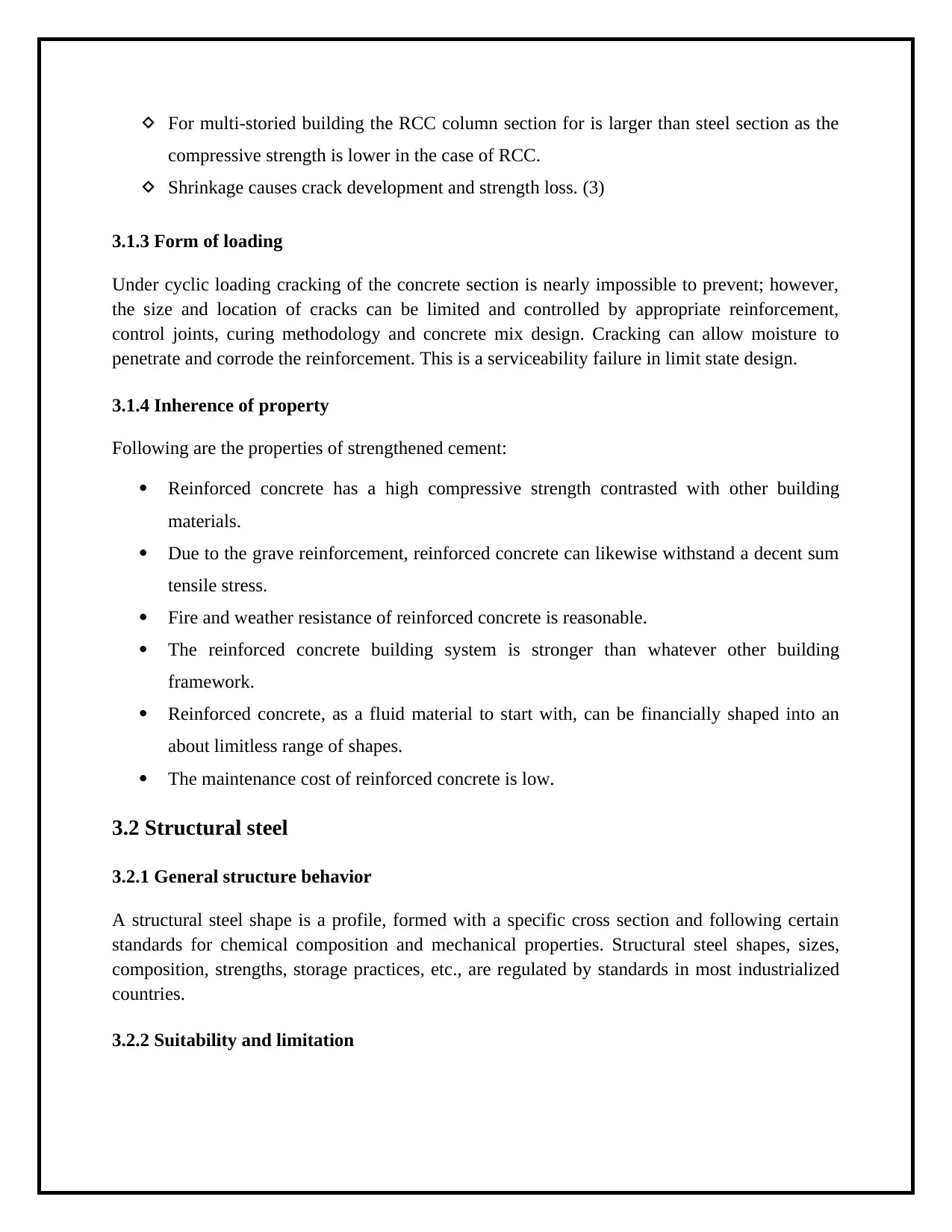
For multi-storied building the RCC column section for is larger than steel section as the
compressive strength is lower in the case of RCC.
Shrinkage causes crack development and strength loss. (3)
3.1.3 Form of loading
Under cyclic loading cracking of the concrete section is nearly impossible to prevent; however,
the size and location of cracks can be limited and controlled by appropriate reinforcement,
control joints, curing methodology and concrete mix design. Cracking can allow moisture to
penetrate and corrode the reinforcement. This is a serviceability failure in limit state design.
3.1.4 Inherence of property
Following are the properties of strengthened cement:
Reinforced concrete has a high compressive strength contrasted with other building
materials.
Due to the grave reinforcement, reinforced concrete can likewise withstand a decent sum
tensile stress.
Fire and weather resistance of reinforced concrete is reasonable.
The reinforced concrete building system is stronger than whatever other building
framework.
Reinforced concrete, as a fluid material to start with, can be financially shaped into an
about limitless range of shapes.
The maintenance cost of reinforced concrete is low.
3.2 Structural steel
3.2.1 General structure behavior
A structural steel shape is a profile, formed with a specific cross section and following certain
standards for chemical composition and mechanical properties. Structural steel shapes, sizes,
composition, strengths, storage practices, etc., are regulated by standards in most industrialized
countries.
3.2.2 Suitability and limitation
compressive strength is lower in the case of RCC.
Shrinkage causes crack development and strength loss. (3)
3.1.3 Form of loading
Under cyclic loading cracking of the concrete section is nearly impossible to prevent; however,
the size and location of cracks can be limited and controlled by appropriate reinforcement,
control joints, curing methodology and concrete mix design. Cracking can allow moisture to
penetrate and corrode the reinforcement. This is a serviceability failure in limit state design.
3.1.4 Inherence of property
Following are the properties of strengthened cement:
Reinforced concrete has a high compressive strength contrasted with other building
materials.
Due to the grave reinforcement, reinforced concrete can likewise withstand a decent sum
tensile stress.
Fire and weather resistance of reinforced concrete is reasonable.
The reinforced concrete building system is stronger than whatever other building
framework.
Reinforced concrete, as a fluid material to start with, can be financially shaped into an
about limitless range of shapes.
The maintenance cost of reinforced concrete is low.
3.2 Structural steel
3.2.1 General structure behavior
A structural steel shape is a profile, formed with a specific cross section and following certain
standards for chemical composition and mechanical properties. Structural steel shapes, sizes,
composition, strengths, storage practices, etc., are regulated by standards in most industrialized
countries.
3.2.2 Suitability and limitation
Paraphrase This Document
Need a fresh take? Get an instant paraphrase of this document with our AI Paraphraser
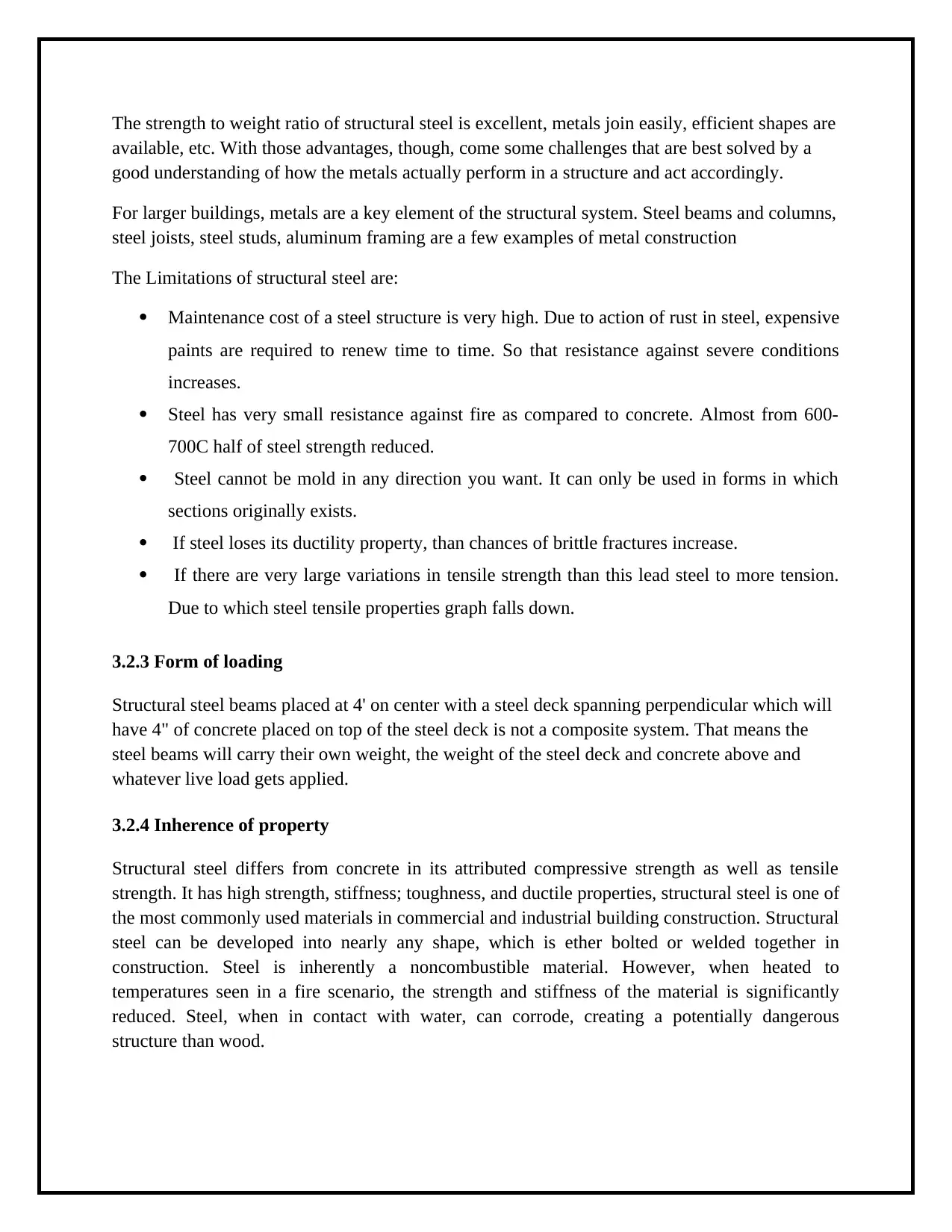
The strength to weight ratio of structural steel is excellent, metals join easily, efficient shapes are
available, etc. With those advantages, though, come some challenges that are best solved by a
good understanding of how the metals actually perform in a structure and act accordingly.
For larger buildings, metals are a key element of the structural system. Steel beams and columns,
steel joists, steel studs, aluminum framing are a few examples of metal construction
The Limitations of structural steel are:
Maintenance cost of a steel structure is very high. Due to action of rust in steel, expensive
paints are required to renew time to time. So that resistance against severe conditions
increases.
Steel has very small resistance against fire as compared to concrete. Almost from 600-
700C half of steel strength reduced.
Steel cannot be mold in any direction you want. It can only be used in forms in which
sections originally exists.
If steel loses its ductility property, than chances of brittle fractures increase.
If there are very large variations in tensile strength than this lead steel to more tension.
Due to which steel tensile properties graph falls down.
3.2.3 Form of loading
Structural steel beams placed at 4' on center with a steel deck spanning perpendicular which will
have 4" of concrete placed on top of the steel deck is not a composite system. That means the
steel beams will carry their own weight, the weight of the steel deck and concrete above and
whatever live load gets applied.
3.2.4 Inherence of property
Structural steel differs from concrete in its attributed compressive strength as well as tensile
strength. It has high strength, stiffness; toughness, and ductile properties, structural steel is one of
the most commonly used materials in commercial and industrial building construction. Structural
steel can be developed into nearly any shape, which is ether bolted or welded together in
construction. Steel is inherently a noncombustible material. However, when heated to
temperatures seen in a fire scenario, the strength and stiffness of the material is significantly
reduced. Steel, when in contact with water, can corrode, creating a potentially dangerous
structure than wood.
available, etc. With those advantages, though, come some challenges that are best solved by a
good understanding of how the metals actually perform in a structure and act accordingly.
For larger buildings, metals are a key element of the structural system. Steel beams and columns,
steel joists, steel studs, aluminum framing are a few examples of metal construction
The Limitations of structural steel are:
Maintenance cost of a steel structure is very high. Due to action of rust in steel, expensive
paints are required to renew time to time. So that resistance against severe conditions
increases.
Steel has very small resistance against fire as compared to concrete. Almost from 600-
700C half of steel strength reduced.
Steel cannot be mold in any direction you want. It can only be used in forms in which
sections originally exists.
If steel loses its ductility property, than chances of brittle fractures increase.
If there are very large variations in tensile strength than this lead steel to more tension.
Due to which steel tensile properties graph falls down.
3.2.3 Form of loading
Structural steel beams placed at 4' on center with a steel deck spanning perpendicular which will
have 4" of concrete placed on top of the steel deck is not a composite system. That means the
steel beams will carry their own weight, the weight of the steel deck and concrete above and
whatever live load gets applied.
3.2.4 Inherence of property
Structural steel differs from concrete in its attributed compressive strength as well as tensile
strength. It has high strength, stiffness; toughness, and ductile properties, structural steel is one of
the most commonly used materials in commercial and industrial building construction. Structural
steel can be developed into nearly any shape, which is ether bolted or welded together in
construction. Steel is inherently a noncombustible material. However, when heated to
temperatures seen in a fire scenario, the strength and stiffness of the material is significantly
reduced. Steel, when in contact with water, can corrode, creating a potentially dangerous
structure than wood.
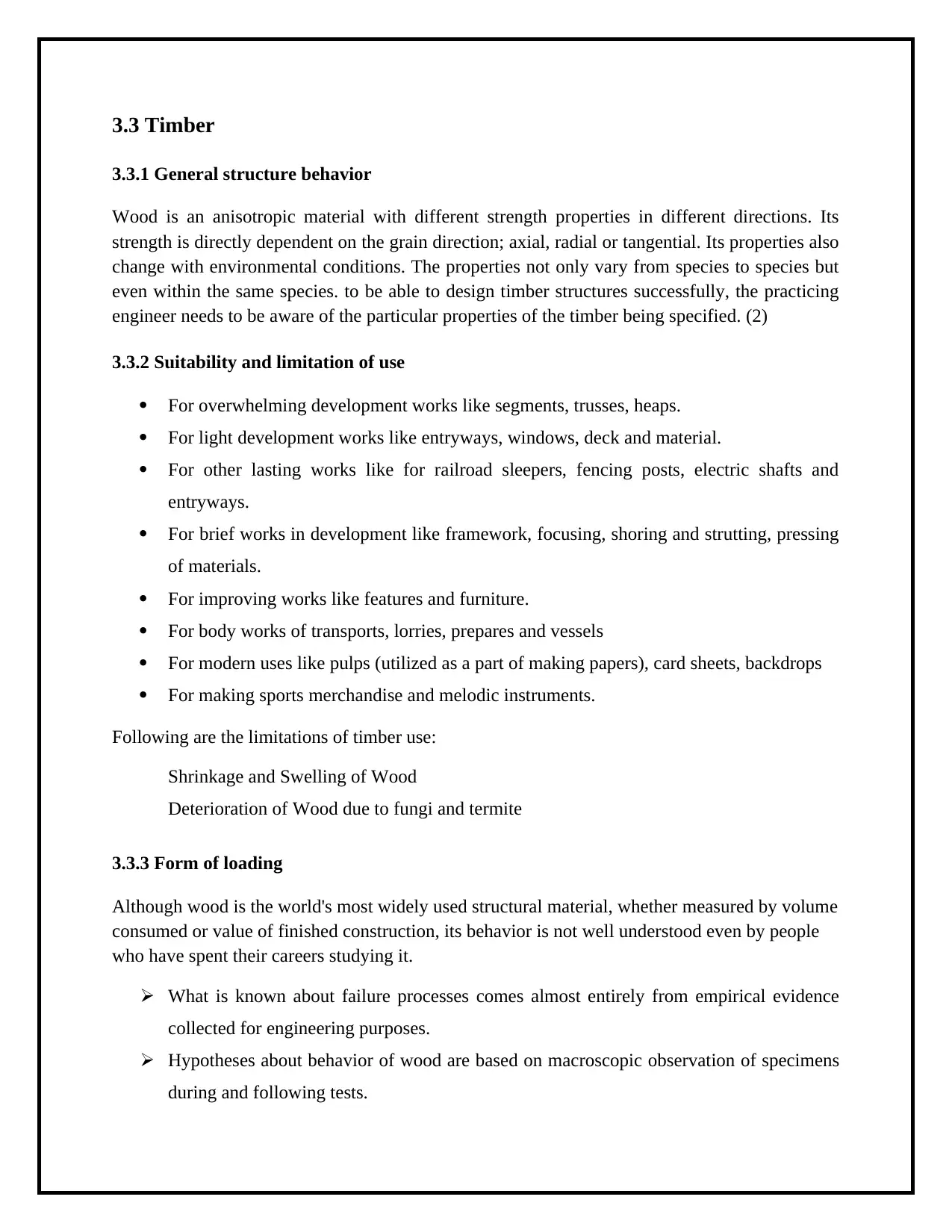
3.3 Timber
3.3.1 General structure behavior
Wood is an anisotropic material with different strength properties in different directions. Its
strength is directly dependent on the grain direction; axial, radial or tangential. Its properties also
change with environmental conditions. The properties not only vary from species to species but
even within the same species. to be able to design timber structures successfully, the practicing
engineer needs to be aware of the particular properties of the timber being specified. (2)
3.3.2 Suitability and limitation of use
For overwhelming development works like segments, trusses, heaps.
For light development works like entryways, windows, deck and material.
For other lasting works like for railroad sleepers, fencing posts, electric shafts and
entryways.
For brief works in development like framework, focusing, shoring and strutting, pressing
of materials.
For improving works like features and furniture.
For body works of transports, lorries, prepares and vessels
For modern uses like pulps (utilized as a part of making papers), card sheets, backdrops
For making sports merchandise and melodic instruments.
Following are the limitations of timber use:
Shrinkage and Swelling of Wood
Deterioration of Wood due to fungi and termite
3.3.3 Form of loading
Although wood is the world's most widely used structural material, whether measured by volume
consumed or value of finished construction, its behavior is not well understood even by people
who have spent their careers studying it.
What is known about failure processes comes almost entirely from empirical evidence
collected for engineering purposes.
Hypotheses about behavior of wood are based on macroscopic observation of specimens
during and following tests.
3.3.1 General structure behavior
Wood is an anisotropic material with different strength properties in different directions. Its
strength is directly dependent on the grain direction; axial, radial or tangential. Its properties also
change with environmental conditions. The properties not only vary from species to species but
even within the same species. to be able to design timber structures successfully, the practicing
engineer needs to be aware of the particular properties of the timber being specified. (2)
3.3.2 Suitability and limitation of use
For overwhelming development works like segments, trusses, heaps.
For light development works like entryways, windows, deck and material.
For other lasting works like for railroad sleepers, fencing posts, electric shafts and
entryways.
For brief works in development like framework, focusing, shoring and strutting, pressing
of materials.
For improving works like features and furniture.
For body works of transports, lorries, prepares and vessels
For modern uses like pulps (utilized as a part of making papers), card sheets, backdrops
For making sports merchandise and melodic instruments.
Following are the limitations of timber use:
Shrinkage and Swelling of Wood
Deterioration of Wood due to fungi and termite
3.3.3 Form of loading
Although wood is the world's most widely used structural material, whether measured by volume
consumed or value of finished construction, its behavior is not well understood even by people
who have spent their careers studying it.
What is known about failure processes comes almost entirely from empirical evidence
collected for engineering purposes.
Hypotheses about behavior of wood are based on macroscopic observation of specimens
during and following tests.
⊘ This is a preview!⊘
Do you want full access?
Subscribe today to unlock all pages.

Trusted by 1+ million students worldwide
1 out of 29
Your All-in-One AI-Powered Toolkit for Academic Success.
+13062052269
info@desklib.com
Available 24*7 on WhatsApp / Email
![[object Object]](/_next/static/media/star-bottom.7253800d.svg)
Unlock your academic potential
Copyright © 2020–2025 A2Z Services. All Rights Reserved. Developed and managed by ZUCOL.

